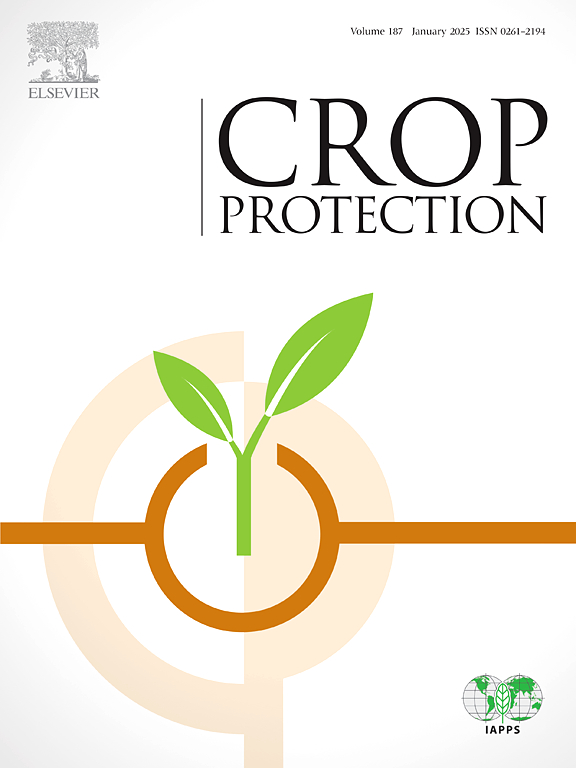The aromatic plant essential oils and their hormetic effect on Rhyzopertha dominica (Coleoptera: Bostrichidae)
IF 2.5
2区 农林科学
Q1 AGRONOMY
引用次数: 0
Abstract
Essential oils (EOs) are increasingly recognized as eco-friendly alternatives to synthetic pesticides due to their biodegradability and reduced risks to non-target species. This study investigates the bioactivity of 30 EOs on Rhyzopertha dominica, a major pest of stored grains, with a focus on their repellency and attractiveness across varying concentrations. The area preference method (APM) was used to evaluate EO bioactivity at concentrations ranging from 0.00064 to 0.064 μL cm−2. The results revealed strong repellent or attractive activity for certain EOs, while others exhibited concentration-dependent dual effects, acting as attractants at lower concentrations and repellents at higher ones. In addition, the bioactivity shown in the APM by nine selected EOs was compared to that obtained by testing the same EOs through a two-choice behavioral bioassay (TCB) at corresponding concentrations. At a 2 % EO concentration, the TCB results indicated significant repellent activity (p < 0.05) for lemon verbena, palo santo, matico, pumin, cinnamon, and anise, which exhibited the strongest effects. In contrast, nutmeg demonstrated significant attractive properties (p < 0.05). Black pepper and mandarin EOs displayed trends toward repellency and attractiveness, respectively. Both methods confirmed the bioactivity of the EOs against R. dominica. These results underscore the concentration-dependent hormetic effects of EOs on R. dominica and highlight the importance of precise optimization in pest management strategies for their application.

芳香植物精油及其对 Rhyzopertha dominica (Coleoptera: Bostrichidae) 的激素作用
精油因其可生物降解性和降低对非目标物种的风险而越来越被认为是合成农药的环保替代品。本研究研究了30种EOs对储藏谷物中主要害虫——纹虫的生物活性,重点研究了它们在不同浓度下的驱避性和吸引力。在0.00064 ~ 0.064 μL cm−2的浓度范围内,采用面积偏好法(APM)评价EO的生物活性。结果表明,某些植物具有较强的驱避或吸引活性,而其他植物则表现出浓度依赖的双重效应,在低浓度时充当引诱剂,在高浓度时充当驱避剂。此外,还比较了9种选择的EOs在APM中所显示的生物活性,并将其与通过两种选择行为生物测定法(TCB)在相应浓度下测试相同EOs所获得的生物活性进行了比较。在2%的EO浓度下,TCB结果显示出显著的驱避活性(p <;0.05),其中对柠檬马鞭草、帕洛桑、麻黄、蒲麻、肉桂和八角的影响最强。相比之下,肉豆蔻显示出显著的吸引力特性(p <;0.05)。黑胡椒和柑桔精油分别表现出驱避和吸引的趋势。两种方法均证实了EOs对多米尼加血吸虫的生物活性。这些结果强调了EOs对小蠹蛾的浓度依赖性激效效应,并强调了精确优化害虫管理策略对其应用的重要性。
本文章由计算机程序翻译,如有差异,请以英文原文为准。
求助全文
约1分钟内获得全文
求助全文
来源期刊

Crop Protection
农林科学-农艺学
CiteScore
6.10
自引率
3.60%
发文量
200
审稿时长
29 days
期刊介绍:
The Editors of Crop Protection especially welcome papers describing an interdisciplinary approach showing how different control strategies can be integrated into practical pest management programs, covering high and low input agricultural systems worldwide. Crop Protection particularly emphasizes the practical aspects of control in the field and for protected crops, and includes work which may lead in the near future to more effective control. The journal does not duplicate the many existing excellent biological science journals, which deal mainly with the more fundamental aspects of plant pathology, applied zoology and weed science. Crop Protection covers all practical aspects of pest, disease and weed control, including the following topics:
-Abiotic damage-
Agronomic control methods-
Assessment of pest and disease damage-
Molecular methods for the detection and assessment of pests and diseases-
Biological control-
Biorational pesticides-
Control of animal pests of world crops-
Control of diseases of crop plants caused by microorganisms-
Control of weeds and integrated management-
Economic considerations-
Effects of plant growth regulators-
Environmental benefits of reduced pesticide use-
Environmental effects of pesticides-
Epidemiology of pests and diseases in relation to control-
GM Crops, and genetic engineering applications-
Importance and control of postharvest crop losses-
Integrated control-
Interrelationships and compatibility among different control strategies-
Invasive species as they relate to implications for crop protection-
Pesticide application methods-
Pest management-
Phytobiomes for pest and disease control-
Resistance management-
Sampling and monitoring schemes for diseases, nematodes, pests and weeds.
 求助内容:
求助内容: 应助结果提醒方式:
应助结果提醒方式:


